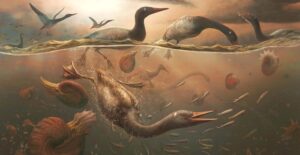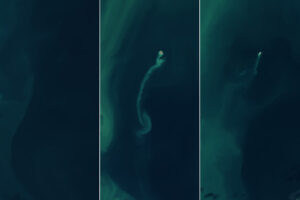In 2020, marine scientists from the Schmidt Ocean Institute discovered the longest animal in the world in Western Australian waters. The almost 50m-long siphonophore surpasses the Lion’s Mane jellyfish, the blue whale, and the Giant Squid in both length and sheer shock factor.

A siphonophore in the deep sea. Photo: Suzan Meldonian/Shutterstock
This alien-like sea creature has existed in our oceans for millions of years. Research into siphonophores began in the 18th and 19th centuries. By now, scientists have recorded 175 species of them, in many different sizes, shapes, and appearances.
Most siphonophores live in the deep sea, but some species dwell on the surface. The most famous siphonophore is the Portuguese Man O’ War, which many mistake for a type of jellyfish. The Portuguese Man O’ War and another siphonophore, Velella Velella, live on the surface.

A dead Portuguese Man O’ War on a beach. Photo: Roberto La Rosa/Shutterstock
In the 1930s, American naturalist William Beebe descended to 97m in a bathysphere and observed a siphonophore, which he described as being “like spun glass.” More recently, in 2020, Nerida Wilson, one of the head researchers of the Schmidt Ocean Institute expedition, described the creature as a “huge organism spread out like a spiral UFO…”
Physiology
Siphonophores belong to the class of animals called Hydrozoa. Many of them, including jellyfish, are gelatinous. They may look like individual animals but siphonophores are actually a colony of thousands of single gelatinous critters called zooids. The zooids replicate themselves asexually to form a long, spiral chain. They connect to each other in a specific order. Each zooid has a specific function. Some eat, some provide movement, some attract prey, and some defend against predators. As siphonophores age, they grow even longer.

Bioluminescent siphonophores above the Hercules ROV, photographed by the Argus vehicle of the Lost City 2005 Expedition. Photo: NOAA
According to marine biologist Stefan Siebert, zooids within the colony communicate via electrical signals which can transmit from one end of the siphonophore to the other.
Siphonophores are not stationary animals that just float around. Larger zooids at the back provide propulsion. They make a repetitive motion by sucking in and squirting out water to enable slow but steady movements.
Predatory behavior
For an animal with no brain, the siphonophore hunts in a very sophisticated manner. It waits for prey to venture into its space. Its tentacles create a spiral net of sorts to trap and paralyze the prey with toxins. Each zooid contains tiny but deadly tentacles that house this toxin.
The siphonophore feasts mostly on krill, plankton, small copepods, and little fish. When the zooids acquire food, they distribute it via food canal to the rest of the colony.

The Lion’s Mane Jellyfish, one of the world’s longest animals. Photo: MilletStudio/Shutterstock
Most siphonophores are also bioluminescent. They can emit green, blue, or red light through their tentilla, which are microscopic capsules hanging from their tentacles. They emits these lights to both confuse and attract prey, blinking their lights in rapid and repetitive fashion.
Since only 5% of our oceans has been explored, it is very possible that animals even longer than this siphonophore exist.






